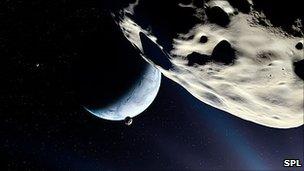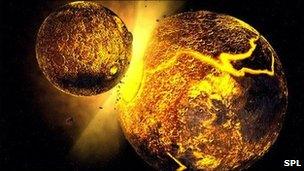Moons like Earth's could be more common than we thought
- Published

The interactions that form comparatively large moons like our own were thought to be rare
About one in 10 rocky planets around stars like our Sun may host a moon proportionally as large as Earth's, researchers say.
Our Moon is disproportionately large - more than a quarter of Earth's diameter - a situation once thought to be rare.
Using computer simulations of planet formation, researchers have now shown that the grand impacts that resulted in our Moon may in fact be common.
The result may also help identify other planets that are hospitable to life.
A report outlining the results, external will be published in Icarus.
Last year, researchers from the University of Zurich's Institute of Theoretical Physics in Switzerland and Ryuja Morishima of the Laboratory for Atmospheric and Space Physics at the University of Colorado in the US undertook a series of simulations to look at the way planets form from gas and smaller chunks of rock called planetesimals.
Our own moon is widely thought to have formed early in the Earth's history when a Mars-sized planet slammed into the Earth, resulting in a disc of molten material encircling the Earth which in time coalesced into the Moon as we know it.
The team used the results from their initial study, external as the input to a further "N-body simulation" to find out the likelihood that large-scale impact events could form large satellites in the same way.
Their results showed that there is about a one in 12 chance of generating a system comprising a planet more than half the Earth's mass and a moon with more than half that of our Moon (taking into account the errors in the simulation, the full range of probabilities was between one in 45 and one in four).
Stabilising influence
Sebastian Elser of the University of Zurich said the new estimates for the likelihood of Moon-sized satellites could inform the hunt for extrasolar planets.
Such large moons can confuse the measurements that spot the planets, and knowing that large satellites may be common could make the measurements easier.

The cataclysmic impact that resulted in the Moon still presents a number of computational mysteries
Also, our Moon has served to stabilise the tilt of the Earth's axis - or its obliquity - which could otherwise have varied drastically over relatively short time scales. That in turn would wreak drastic changes to the way heat from the Sun is distributed around the planet.
It thus can be said that the Moon's presence made a more stable environment in which life could evolve, Mr Elser said.
"Checking for the possibility of an obliquity-stabilising moon is a good thing if you're trying to find out how many habitable worlds are out there in the galaxy," he told BBC News. "But it's surely not the only one and not the most important."
Eiichiro Kokubo is a planet formation expert who has published widely on the mechanics behind the development of both the planets in our Solar System and the Moon.
He called the result an "interesting estimate" but cautioned that there are several as-yet unknown parameters "which greatly affect lunar formation and evolution and thus the probability of hosting a large moon".
He told BBC News that, for example, it is still impossible to put numbers to the effects of a planet's initial spin before impact, or how the disc of material is formed and evolves after it.
"I think we should take the paper as a trial calculation based on what we know about formation of terrestrial planets and moons today," he said.
- Published26 May 2011
- Published6 October 2010